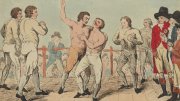Before Lenny Bruce and George Carlin, there was MAD magazine. The progenitor of anti-establishment humor—often silly, always subversive—was first published in 1952 and for the next nearly seven decades, the magazine’s writers and cartoonists gleefully spoofed and harpooned nearly every aspect of American culture—from McCarthyism and the Cold War to celebrity worship, consumerism, and the counterculture movements of the 1960s and 1970s. It became a font of irreverence for a young generation learning to question authority. MAD’s creators “tackled contemporary events through the lens of humor, asking people to look a little more carefully at what they were being told,” says Stephanie Plunkett, chief curator at the Norman Rockwell Museum, in Stockbridge, Massachusetts, which has organized the retrospective exhibition What, Me Worry? The Art and Humor of MAD Magazine, through October 27.
The show offers more than 200 original illustrations, along with photographs, video, memorabilia, and interactive features that explain the reverberating impact of the publication (among its young fans were aspiring satirists Jon Stewart and Stephen Colbert). It also highlights the publication’s power as “a crucial venue for cultural commentary and norm-busting humor delivered through predominantly visual media,” says museum director/CEO Laurie Norton Moffatt. “We are keenly aware that MAD magazine raised issues, often presciently, that continue to drive contemporary debates and struggles…that remain to be worked through.”









